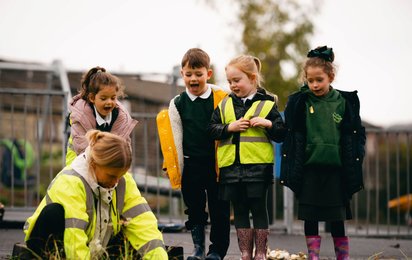
Active Design
Where we live, work, travel and play has a major role in shaping our activity choices.
The foundation principle of ‘Activity for all’ is supported by the remaining principles which are brought together under the three themes of ‘Supporting active travel’, ‘Active, high-quality places & spaces’ and ‘Creating & maintaining activity’.

By applying Active Design’s 10 principles to our built and natural environments, we can create active environments that encourage people to be active through their everyday lives.
All environments should support physical activity equitably across all ages,
ethnicities, genders, and abilities, enabling everyone to be active and build
long-term active habits and behaviours. This is essential for the delivery of
all the principles of Active Design and is its foundational principle.
Facilities for daily essentials and recreation should be within easy reach
of each other by active travel means, making it more likely that people
will make the journey by using active travel modes (defined in Theme 1).
Good active travel connections should be provided to extend the range of
services that are accessible while remaining physically active.
Encourage active travel for all ages and abilities by creating a continuous
network of routes connecting places safely and directly. Networks should be
easy to use, supported by signage and landmarks to help people find their way.
People are more likely to combine trips and use active travel to get to
destinations with multiple reasons to visit. Places with more variety,
higher densities, and a mix of uses also reduce the perception of distance
when travelling through spaces. They also generate the critical mass of
travel demand to better support public transport services.
Accessible and high quality open space should be promoted across cities,
towns and villages to provide opportunities for sport and physical activity,
as well as active travel connections and natural or civic space for people to
congregate in and enjoy.
Streets and outdoor public spaces should be Active Environments in their
own right. They should be safe, attractive, functional, prioritise people
and able to host a mix of uses, with durable, high quality materials, street
furniture in the right places and easy-to-use signage. High quality streets
and spaces encourage activity, whereas poor quality streets and spaces
are much less likely to be used to the same degree.
Infrastructure to enable sport, recreation and physical activity to take
place should be provided across all contexts including workplaces, sports
facilities and public space, to facilitate activity for all.
Buildings we occupy shape our everyday lives, both when users are inside
and outside. Buildings should be designed with providing opportunities
for physical activity at the forefront, considering the arrival experience,
internal circulation, opportunities to get up and move about, and making
the building an active destination.
Spaces and facilities should be effectively maintained and managed to
support physical activity. These places should be monitored to understand
how they are used, and flexible so that they can be adapted as needed.
The provision of spaces and facilities which can help to improve physical
activity should be supported by a commitment to activate them,
encouraging people to be more physically active and increasing the
awareness of activity opportunities within a community.

Steven Heywood
Active Design Manager
07772 586778
steven.heywood@yorkshiresport.org
What's new in active design
Press
Sharing the Learning on Active Design
The latest event shared learning about how to create healthy, active places through active design…
24 Oct 2025
Funding
The Government has announced £150 million for 95 areas through the Pride in Place Impact Fund.
26 Sept 2025
Plans to boost walking, wheeling and cycling in West…
Safer routes to schools and improvements to greenways and towpaths are amongst plans to boost active…
13 Aug 2025
Calderdale featured in Active Travel webinar
Calderdale Council will discuss how the Ash Green community streets scheme is making it safer and…
12 Aug 2025
The theme for #Playday2025 is - Spaces for Play
Today is #Playday2025, the UK’s national day for play, highlighting every child’s right to play and…
6 Aug 2025
Press
Mayor Oliver Coppard champions South Yorkshire’s…
South Yorkshire’s Mayor Oliver Coppard has signed a landmark agreement to boost sport and physical…
17 Jul 2025
Read more news, funding, jobs, courses and events





